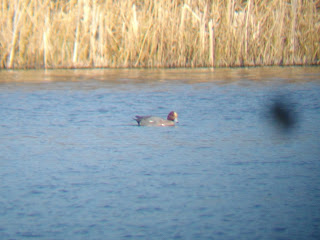25th March 2016
A bright and sunny Good Friday held lots of possibilities, with several inland Common Scoters about, a pair of my patch-nemesis duck (Garganey) arriving at Strumpshaw, Sand Martins beginning to appear and lots of insects emerging. I briefly went shopping to stock up on hot cross buns (meeting hoverfly recorder Stuart Paston in the process) before heading down to Whitlingham for a stroll.
Upon arrival a Peacock butterfly flew across the car park, however it was to be my only butterfly sighting of the day. Whilst Whitlingham can be a blaze of colour in late spring, in March and April there are large expanses without many flowers, so it is not one of the better places locally for early spring butterflies. I studiously checked each patch of Lesser Celandine and Coltsfoot for hoverflies, but the first interesting insects I noticed were a patch of metallic blue beetles. I had seen a photo of a similar group of beetles taken by Perry Hampson along the North Walsham-Dilham canal, and I suspected that they were a type of Flea Beetle (Altica sp). I tried to move a stick near one and the closest beetles jumped up in the air, firming up my suspicions. County beetle recorder Martin Collier has confirmed that they are indeed one of the Altica species. Unfortunately there are several, and they can only be identified to species level by dissection, so I'm just recording them to genus.
Further along the Little Broad I heard my first singing Chiffchaff of the year, and a Kingfisher called as it whizzed past. Some more flower checking led me to find two small ladybirds, a red 24-spot Ladybird and a yellow 22-spot Ladybird. I also noticed some white spots on White Dead Nettle leaves, caused by a fungus. There are a couple of possibilities, so hopefully I can identify it. The standard reference work for microfungi on plants is very good, but relies completely on descriptions. Ideally I would like to see a picture first, to make sure I was in the right area, before then moving on to the detailed description. There doesn't seem to be much demand - maybe I'll have to write it myself! I hope to learn a bit more about microfungi on the NNNS Microfungi workshop, to be held at Wheatfen on 10th April.
24-spot Ladybird - a small species that is easy to overlook
Fungal spots on White Dead Nettle - two possible contenders for the species though
I scanned both broads in the hope that an early Sand Martin would be flying about, but with no success. Carrying on along the south shore of the Great Broad I heard a rapid-fire clicking noise. Recognising it as a camera on burst mode I looked around and found a photographer lying on the ground, taking photographs of a pair of Egyptian Geese with two goslings. With no such photographical standards I let him finish and then took a record shot as they disappeared off across the broad.
Egyptian Geese with first goslings of the year. Take a good look now in case it doesn't make the Bird photograph of the year awards shortlist.
Because of the sunshine the CP was very busy, especially with dog walkers and families. On the water it was fairly quiet, so I decided to count the migratory species. I counted 82 Tufted Ducks, 1 Teal, no Gadwall or Pochard, but interestingly seven Wigeon. This was my first ever March record here, surprisingly. Several people had heard them flying over Norwich during the night, so presumably these ones just stopped in on their way out of the county.
Over the river at Thorpe some children were out on the spit in the middle of the broad, so no birds on there. The recent management work has opened up the area nearby, but there are fences and signs clearly telling people that the area is off limits, so it is frustrating that people choose to ignore the signs and trespass on part of the nature reserve. Benches are provided on the shingle area to the west of the broad for people wanting to sit and observe the broad. There were a few birds left in the near corner of the broad, including four Gadwall and around 35 Tufted Ducks.
Having completed my circuit I had heard five singing Chiffchaffs, four at intervals around the Great Broad and another just across the river near Thorpe Green. A silent sixth bird gave great views as it caught flies a few feet from my head. I also got close views of a Goldcrest as it flicked through the undergrowth. As it turned out I only saw one new patch species, Hairy-footed Flower Bee, but I still had an enjoyable walk in the sunshine.






No comments:
Post a Comment